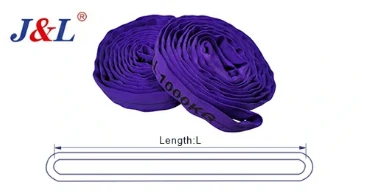Why Choose a Round Sling for Industrial Rigging?
July 22, 2025
In modern industrial lifting, safety, flexibility, and load protection are top priorities. Among the many lifting tools available, round slings have become a widely trusted solution for various heavy-duty rigging operations. But what makes round slings the preferred choice across so many sectors—from construction to logistics?
This article gives a comprehensive overview of the benefits of round slings compared to other slings for rigging, such as grommet slings. Additionally, it provides invaluable guidance on selecting the right products from such leading round sling manufacturers as Juli Sling, which will ensure the guarantee of full safety, high performance, and long-lasting usage.

What Is a Round Sling?
A round sling is a flexible lifting sling made of high-strength polyester or synthetic fiber yarn, enclosed in a durable protective sleeve. Its endless-loop design allows for multi-directional lifting, load balance, and gentle handling of sensitive surfaces.
Round slings are commonly used for lifting machinery, steel structures, concrete beams, and delicate components where traditional chain or wire rope slings may cause abrasion or surface damage. Their ability to mold to the shape of a load makes them exceptionally versatile in complex rigging setups.
Advantages of Using Round Slings
Unlike rigid lifting devices, round slings offer adaptability and load surface protection. They’re color-coded by lifting capacity, lightweight, and easy to inspect visually. Here’s why they stand out among other slings for rigging:
- Soft contact: Ideal for lifting painted, polished, or fragile loads
- Lightweight and flexible: Easy to transport, store, and maneuver
- Endless loop design: Increases strength and distributes load evenly
- Reduced risk of injury: Compared to heavier steel or chain slings
- Cost-effective: Long service life with proper care
For applications involving curved or uneven loads, round slings reduce pressure points and offer better lifting stability.
How Do Round Slings Compare to Grommet Slings?
The direct approach to lifting is through the use of grommet slings, specifically those made of wire rope. The round slings are better for the environment in places where surface protection and sling flexibility have to be considered.
These large-hole slings are thicker and are generally meant for marine, offshore, or steel fabrication sectors. Still, they are typically not that comfortable for people to use as compared to the soft round slings because of the lack of a grip feature. They each have their purpose to serve, but the one that is selected depends on a number of agile lifting work, material sensitivity, and working conditions factors.
Common Industrial Uses
Round slings are widely adopted across industries thanks to their strength and adaptability. They’re commonly found in:
- Machinery installation and removal
- Prefabricated concrete handling
- Bridge and building construction
- Warehouse loading and unloading
- Aerospace and shipyard applications
Trusted round sling manufacturers like Juli Sling also provide custom sling lengths, safety labels, and detailed usage guides to ensure compliance and safe operation in all scenarios.
Why Juli Sling?
As one of China’s top round sling manufacturers, Juli Sling provides a complete range of slings for rigging, including round slings, webbing slings, and grommet slings for heavy industrial lifting. Each product meets international safety standards such as EN1492 and ASME B30.9, and is thoroughly tested before shipment.
Juli Sling offers slings in multiple load capacities, lengths, and configurations, with custom branding and technical support available. Whether you need gentle lifting solutions for sensitive equipment or rugged slings for steel beams, Juli has a solution backed by decades of rigging expertise.
